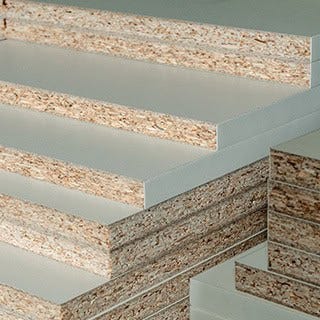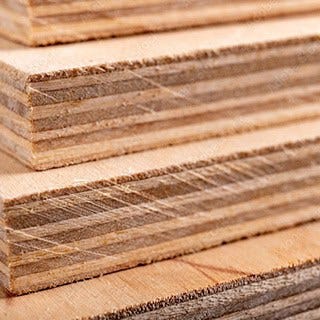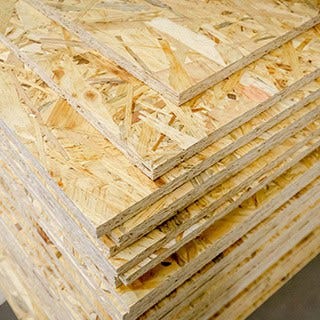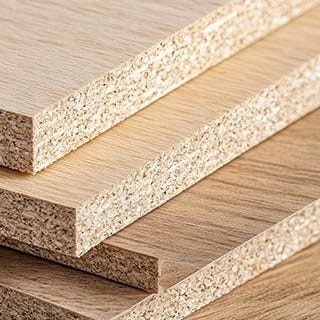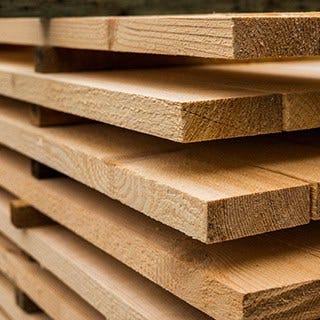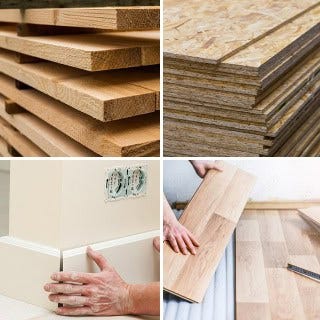MDF Boards: What Are They and What Are They Used For
MDF boards are used throughout our homes, from our furniture to our wall panelling, and even our floors. It is a cost-effective substitute for using real wood, which brings a series of benefits and several drawbacks with it. In this overview of MDF boards from Building Materials Nationwide, we’ll cover their pros and cons, their popular uses, and the different types for sale within the UK.
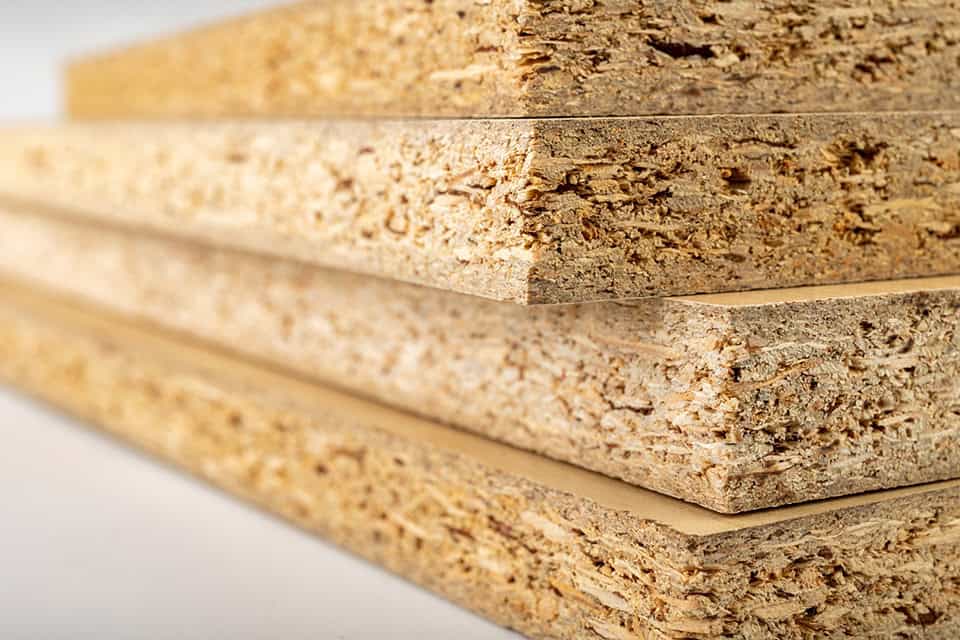

What is MDF?
MDF stands for Medium Density Fibreboard, and is an engineered wood product, often sold as boards or sheets. It is produced from the byproducts of industrial milling, either sawdust or shavings of wood. These will be dried, combined with resin and wax, and moulded into panels. These panels will be treated with heat and pressure, compressing them into rigid shapes. This will then be sanded and cut into set dimensions, which can then be sold as MDF boards.
What Are the Benefits of MDF Boards?
MDF has a variety of benefits within building projects:
- Lower Cost Than Wood: MDF boards will come at a cheaper cost than real wood, and can be laminated to give the appearance of genuine wood products.
- Visual Choice: MDF can be stained, painted, or covered in veneers to give the impression of real wood. It is also far quicker to stain and colour than natural wood.
- Smooth Appearance: MDF offers a smooth look, without any of the imperfections that can occur with real wood. It also will not fluctuate in size due to temperature to the same extent as wood.
- Resistant to Insects: The chemicals used during the manufacturing process will give MDF resistance to insects like termites.
- Environmentally Friendly: As MDF is made from discarded parts of the wood manufacturing process, it helps to minimise waste.
- Easy to Drill and Cut to Size: MDF lacks grain, meaning you can easily drill into it without damage occurring. You can also use machines on it to cut it into a wide variety of shapes.
What Are the Downsides of MDF Boards?
While there are clear benefits of using MDF within a building project, it also possesses some key drawbacks:
- Comparative Lack of Strength: Compared to real wood MDF boards will not be as strong, and will not stand the extreme pressures that wood can. It also won’t possess the lifespan of real wood.
- Difficulties With Use: MDF will require more nails for use than real wood, as it has a lower density. In general, it can be challenging to insert nails or screws into MDF.
- Health Issues: MDF often contains urea-formaldehyde, though European manufacturers tend to only produce low-emission MDF. As formaldehyde is released when MDF is cut, precautions will have to be taken to ensure safety.
How Do MDF Boards Compare to Plywood?
Plywood is another popular engineered wood product used within UK constructions, that has some benefits and drawbacks compared to MDF:
- Price: MDF will come at a lower cost than plywood in general, though both will be cheaper than using real wood.
- Visual: Plywood looks more like real wood than MDF, with a realistic grain. When it comes to decorating, MDF is far easier to paint, while plywood can have a more effective stained wood look.
- Strength: Plywood boasts a greater strength than MDF, despite the heavier weight of MDF. When it comes to usage within a project, MDF is easier to cut, with plywood unsuited for elaborate edging or curves on applications like skirting. You’ll also need to finish the edges of the plywood to avoid showing the layers of wood, which isn’t an issue with MDF. Screws hold better within Plywood, due to its strength. Both kinds of engineered wood can release toxic fumes when cut.
- External Usage: While its insect resistance is useful outdoors, MDF can soak up water easily, leading to swollen, warped boards. Plywood is not immune to water damage, but will hold up better over time.
Which of the two is right for your project will vary on several factors including your needs and your budget. MDF is traditionally used for interior furniture and decorations due to its ability to be intricately carved and painted. Plywood can be used for more strength-based roles and exterior uses.
What Are the Uses of MDF Boards?
MDF has several uses within construction but is largely used for furniture building, particularly on the economic side.
Furniture
MDF is commonly used for making furniture, both pre-built and flatpack. This could be shelving, cabinets, or other decorative designs. When joined together, MDF cabinets can be strong enough for general use, though they will offer a lower level of strength than normal wood. For shelving, MDF can sag in extended lengths, so a solid wood underframe will probably be needed. The ease of painting and other decoration methods on MDF will also bring benefits, allowing a wide range of looks to be easily applied.
Flooring
MDF boards can be used as temporary flooring, cut into attractive boards. As MDF has a shorter shelf life than real wood, this is not a permanent installation. It’s also worth remembering that MDF and water do not mix. This means that using MDF as flooring within a kitchen or bathroom can be a recipe for trouble, with boards swelling from any spilt water, though water-resistant models are available. Due to its low cost, MDF can be an excellent temporary flooring solution.
Skirting
MDF is used to construct smooth skirting boards for use throughout a house. Due to its lack of grain and defects, MDF can give a pristine look, and can also be coated in a wide range of colours. The ease of sculpting MDF also allows for a variety of skirting board designs.
Window Sills
Due to its smoothness and easy decoration, MDF is popularly used for window sills. MDF can be carved into a rounded shape and painted in colours such as white. When buying window sills made from MDF you should be looking to buy moisture-resistant models, due to the threats of moisture.
Panelling
MDF panels can be used as low-cost wall panelling, giving a suite of style options to your walls. From Jacobean panelling with a grid design, to vertical boards, to more experimental looks. MDF can be cut to size and installed on your wall, and painted over to give a beautiful and unique look. Using MDF for wall panelling has grown in popularity in recent years, giving texture to the walls of a home.
How to Cut MDF Board
Chipping can be an issue when cutting MDF, which you can limit by using quality cutting equipment. You should opt for a circular saw when making straight cuts, using a fine blade with a carbide tip for the best results. For curved cuts, a jigsaw with a bi-metal blade should be used. Using a fine-toothed model is also advised.
Do I Need to Wear Protection When Cutting MDF?
While you should wear gloves and a long shirt (with tight sleeves) whenever operating a saw to protect yourself, when cutting MDF it’s also important to use a gas mask and safety goggles, due to the amount of dust that will be released, including potentially formaldehyde. You should cut MDF within an area where you will be easily able to clean away all dust afterwards.
How to Paint MDF
When cutting MDF you’ll need to cover the newly cut edges. If leaving hidden you can just smooth the edges down. If visible you’ll have the options of using wood filler and rubbing it level or using MDF edging tape. Before painting MDF you’ll need to use a primer, to ensure some protection against water. Your primed MDF board can be painted in many different ways, with paints like gloss or satinwood working well. You’ll likely need either two or three coats, sanding between quotes and clearing away dust.
How is MDF Sold in the UK?
There are several specific types of MDF boards for sale in the UK, with their own visual or structural benefits. Structurally, you’ll have several unique options available for sale:
- Moisture Resistant MDF: These boards will be able to work within wet environments like bathrooms and kitchens, unlike regular MDF.
- Flame Retardant MDF: Available for use as fire-resistant panelling, this product can be used for non-structural purposes within a fire safety plan.
- Light MDF: Ultralight MDF offers a lower weight due to its reduced density. This can be used within furniture but will offer reduced strength compared to standard MDF boards.
Visually, there are a few specific products available, giving a unique look for your project de to their unique finishing:
- Veneered MDF: Wooden veneers can be attached to MDF boards, giving the impression of a full wooden board. This can offer a great professional look, while still coming at a lower cost than real wooden panels within furniture construction.
- Laminated MDF: Alternatively to authentic veneers, laminate surfacing can be used on MDF boards, offering a wood-like appearance that is durable and resistant to scratching. This can also be used throughout furniture making.
- White Melamine MDF: This is a standardised MDF board with a white facing on both sides, commonly used within furniture jobs like wardrobes and stands. Buying white melamine MDF can save you time priming and painting MDF.
How Long Does MDF Last?
Compared to real wood MDF will have a shorter lifespan, with around 14 to 20 years the standard. This will mean that items like MDF furniture, flooring, window sills, and skirting have a specific window before which they will degrade and likely need to be replaced. This is something to keep in mind when factoring the cost of MDF products against other engineered wood and authentic wood products.
Our Range of MDF Boards For Sale
Building Materials Nationwide works with building companies, contractors, and DIYers alike across the UK, offering a comprehensive range of building supplies for delivery. Within our Sheet Materials section, you’ll find our choice of MDF Sheets, with solid and bendy choices, along with adhesives and MDF acoustic decks.
As a business we aim to take the hassle out of sourcing building supplies, offering everything a builder could need from a single location. For those within the industry, we offer trade accounts, giving our members access to our full network of suppliers, express delivery options, and their own dedicated account manager, who can help with large or specific orders. Sign up for a trade account through our website today.
Buy top-notch Gyproc moisture resistant plasterboard
Building Materials Nationwide offers a wide selection of compliant Gyproc moisture resistant board options. It is perfect for use with tiles and in damp or humid areas such as bathrooms and kitchens.
Our materials adhere to industry standards, providing reliable performance and durability. With quality options from top manufacturers like British Gypsum and Knauf, you can trust us for your moisture resistant plasterboard materials.
Building Materials Nationwide offers convenience and streamlined ordering when you open a trade account. Enjoy competitive trade prices, speedy deliveries and flexible credit terms subject to eligibility.
The dedicated trade account management team supports you in finding the right products and ensuring your projects meet all regulatory requirements. Partner with us for seamless access to high-quality building materials. Sign up now or contact us for a chat.
More like this
- Your Best Options for Stud Wall Insulation
- Loft Insulation Installation: Trade Tips and Common Mistakes
- Everything You Need to Know About Foam Board Insulation

